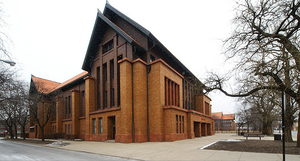Could we imagine that the intersection of the Prairie School of architecture and progressive education marks a particular strategy of reworking the the urban topology? In it’s rejection of neo-classical ornament and scale–school as urban citadel–we might see not simply a ruthless break with history, but an attempt to draw to the surface a perennial dream of education itself.
As Kevin D. Murphy notes, progressive schools in Chicago in the early 20th century, for instance, represented a kind of inverted space: their interiors taking on the function of an idealized public space in which the city can come together. It is no doubt no accident that we see an upsurge in public parks as well. architecturally, the long horizontals and breaking of the barriers of the facade do not just intend to represent the prairie externally, but in some way to turn the city inside out. Or rather, outside in. A porous horizon in the midst of the city.
And yet, as the barrier between inside and out is reduced, we see not so much a naturalized education, but the industrial workings of the city reflected in the school. The prairie becomes a factory. Or is it the other way around?
As Murphy notes, the industrial skyscraper of Louis H. Sullivan was at home covered in terra cotta foliage. But even beyond that, can we find in the bare geometry, and stark materiality of even more stripped down forms an evocation of nature in the form of the plain itself? Skyscrapers as the vertical ascent of the plain?
In any case, this is a troubled vernacular for schools. Dwight H. Perkins was damned for stripping the Chicago city school of it’s ornamental history and looking out to the horizon, but also damned for evoking there the stark lines of factories.
Did not the classic city prefer to keep it’s gardens pure, if at a distance?
We should perhaps reflect on the early topology of the city. With the first cities it went something like this, in concentric circles: mountain/sea–agrarian plains–lower city–agora–acropolis. Education went from lower city up. But the turn to the horizon was not unrepresented either. Indeed, the rituals of the city might easily involve sacrificial trips to the edges of the territory before returning. Although, the sacrificial function makes the geographic value particularly ambivalent. Which is to say, if we imagine the purity of nature, it is perhaps in part because it threatens us. The test of purity. (Isn’t this the theme of any number of Spaghetti Westerns? As if the proper place for the Puritan is on the frontier, surrounded by Indians and outcasts.)
But this image of a pure horizon is largely speculative, especially within the Prairie school of architecture. That is, it is specifically a city image of the prairie, with its natural habitat the suburbs. And even then it prefers to glorify the horizon at a distance.
One cannot help but think of Achilles’ backhanded compliment to the farmer, (tellingly evoked by Plato in the context of the cave allegory) as he turns down the throne of Hades:
I would rather work the soil for a poorly tenant farmer, than rule over all the dead who have perished.
If we can admit my, granted, unusual translation, we thus have a weird leaping of topology. On the one hand, the cave is typically conceived as being of the mountains, but it was also something beneath a far away city. One went over the mountains and down. But then by extension, the cave is also immediately below one’s own city as well, as Plato seems to suggest. The cavernous underworld is the Piraeus, the port city of Athens, marked by the first words of The Republic: “I went down to the Piraeus…”
The cave is both far and near.
But likewise Achilles is seeming to set up a parallel leap of resonance, suggesting that the agrarian plains are preferable to the underworld, and are closer to his noble stature. It is as if, in the view from the Acropolis, a cosmopolitan Athenian would prefer to look out past the lower city to the plains. This is the backhanded compliment both linking and distancing the plain from the Acropolis: better that I be even a farmer than a foreign dweller in the inner city. And we should recall that in Chicago at the time, the pressing educational question was what to do with the influx of new immigrants. The answer seems to be to send them, at least metaphorically, to the fields.
Which is to say, by way of an odd spatial logic, to the factories.
